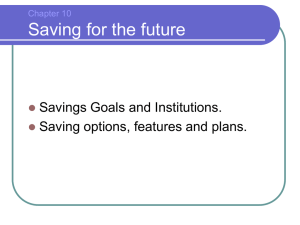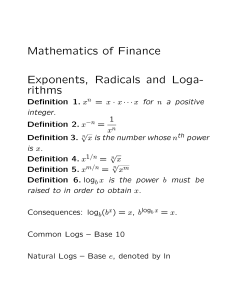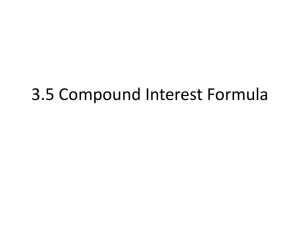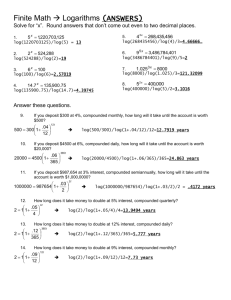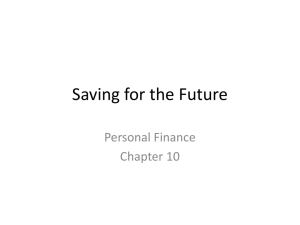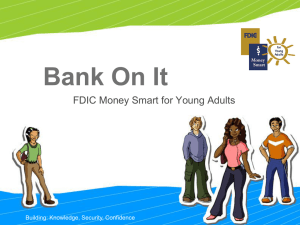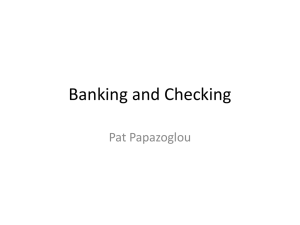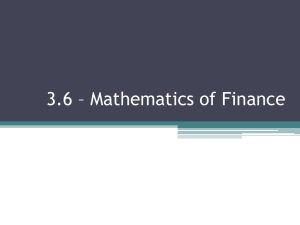Simple interest
advertisement
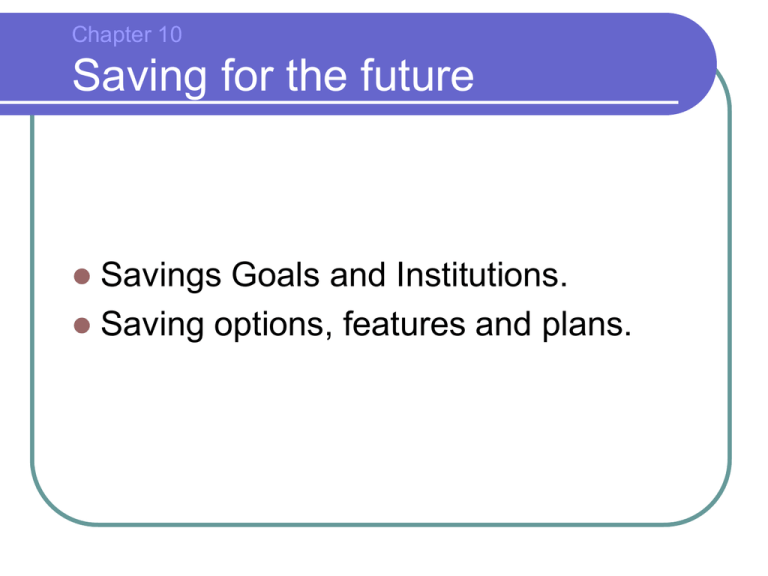
Chapter 10 Saving for the future Savings Goals and Institutions. Saving options, features and plans. Lesson 10.1 Savings Goals and Institutions Describe different purposes of saving. Explain how money grows through compounding interest. List and describe the financial institutions where you can save. Why You Should Save Short-term needs Emergencies Long-term needs Home ownership Education Retirement Investing Financial security Why Save 76% of Americans live paycheck to paycheck Emergencies – dip into savings vs credit card Furnace goes out Car insurance Lose job Save 3-6 months of $ for bills Pay Yourself First vs. discretionary income – save after you pay bills Automatic Deposit into Savings Save $100 per paycheck OR 10% per paycheck If you don’t have it, you won’t spend it Where You Can Save Commercial banks – corporated financial services (loans, deposits, trading HSBC Bank, Bank of America Savings banks – main purpose to store savings for private depositors Overseas Where can you Save Savings and loan associations – similar to credit unions Credit unions – owned by the depositors -Educational Credit Union, Kellogg Credit Union Brokerage firms – buying and selling of securities (CDs) Charles Schwab, Fidelity Factors to consider Liquidity – how quickly can you get money out Safety – able to get money back Convenience – where you find and get access to Interest-Earning potential (Yield) – how much money you can make Higher the interest yield the better Fees and Restrictions – Minimum balance, transaction fee Saving Options Regular savings account High liquidity Lower interest Free to make withdrawals and deposits Service fees may apply Can use ATM/Debit cards Saving Options Certificate of Deposit (CD) Earns a fixed interest rate for a specified length of time Requires a minimum deposit Higher interest rate then regular savings Must leave money in for the entire time Has a set maturity date-the date the investment becomes due for payment Saving Options Money market account Combination savings-investment plan Interest rates go up and down with the stock market Money is used to purchase safe, liquid securities Offered by banks and brokerage firms Money can be deposited/withdrawn at any time with no fee Usually not insured Saving Regularly Ways to Save Must spend less money than you take in Direct Deposit Automatic Payroll Deductions Types of Interest Interest is based on interest rate and principal (balance) Simple interest is calculated on principal only Compound interest is money earned on the money deposited plus previous interest Simple Interest I prt I=Interest p=principal r=interest rate t=number of years Example 1 Simple interest Grace wants to deposit $5000 in a certificate of deposit for a period of two years. She is comparing interest rates quoted by three local banks and one online bank. Write the interest rates in ascending order. Which bank pays the highest interest for this two-year CD? Example 1 continued First State Bank: 4 1 % 4 E-Save Bank: 3 4 % 8 Johnson City Trust: 4.22% Land Savings Bank: 4.3% Simple Interest example 2 Raoul’s Savings account must have at least $500, or he is charged a $4 fee. His balance was $716.23, when he withdrew $225. Will he be charged a fee? Simple Interest Example 3 Mitchell deposits $1200 in an account that pays 4.5% simple interest. He keeps the money in the account for three years. How much is in the account after three years? Simple Interest Example 4 How much simple interest does $200 earn in 7 months at an interest rate of 5%? Simple Interest Example 5 How much principal must be deposited to earn $1000 simple interest in 2 years at a rate of 5%? Simple Interest Example 6 Derek has a bank account that pays 4.1% simple interest. The balance is $910. When will the account grow to $1000? Simple Interest Example 7 Kerry invests $5000 in a simple interest account for 5 years. What interest rate must the account pay so there is $6000 at the end of 5 years? Compound Interest Terms Annual compounding-once each year Semiannual Compounding-twice a year Quarterly compounding-4 times a year Daily compounding-365 times a year (366 in a leap year) Crediting is how much an account earns per month (all the compounding is added up then) Additional Information Compound daily and credit monthly is most common produce used by banks today. APR (annual percentage rate) – annual interest rate for simple interest APY (annual percentage yield) – annual interest rate that takes the effect of compounding Compound Interest Formula B=ending balance p=principal r=interest rate n=number of times interest is compounded annually t=number of years r nt B p(1 ) n Example 1 Marie deposits $1650 for three years at 3% interest, compounded daily. What is her ending balance? Example 2 Kate deposits $2350 in an account that earns interest at a rate of 3.1%, compounded monthly. What is her ending balance after five years? APY/APR APR-annual percentage rate APY-annual percentage yield Banks usually advertise Higher than APR for accounts compounded more than once per year Annual percentage yield formula r= interest rate N=number of times per year r n APY (1 ) 1 n Example 1 Sharon deposits $8000 in a one year CD at 3.2% interest, compounded daily. What is Sharon’s annual percentage yield (APY) to the nearest hundredth of a percent? Example 2 Barbara deposits $3000 in a one year CD at 4.1% interest, compounded daily. What is the APY to the nearest hundredth of a percent? Continuous Interest Infinite or without limiting time B Pe B=ending balance P=principal E=exponential base (on Calc) r=interest rate t=number of years rt Example 1 Craig deposits $5000 at 5.12% interest, compounded continuously for four years. What would his ending balance be to the nearest cent? Example 2 If you deposit $1000 at 4.3% interest, compounded continuously, what would your ending balance be to the nearest cent after five years? Present value How much money you need now for a certain $ amount later “Putting money in now will get you how much later” Present Value of a single deposit Periodic investments are the same deposits made at regular intervals such as yearly, monthly, biweekly, etc. Present Value Of A Single Deposit B P r nt (1 ) n Example 1 A mom knows that in 6 years, her daughter will attend College. She will need about$20,000 for the first year’s tuition. How much should the mom deposit into an account that yields 5% interest, compounded annually? Example 2 Ritika just graduated from college. She wants $100,000 in her savings account after 10 years. How much must she deposit in that account now at a 3.8% interest rate, compounded daily, in order to meet that goal? Present Value Of A Periodic Deposit r B( ) n P r nt (1 ) 1 n Example 1 Nick wants to install central air conditioning in his home in 3 years. He estimates the total cost to be $15000. How much must he deposit monthly into an account that pays 4% interest, compounded monthly, in order to have enough money? Future Value What will the future balance be if you deposit money now. Future Value of the Investment B - balance at end of investment P - periodic deposits r – interest rate n – number of times compounded t - length of time B = P ((1 + r/n) nt - 1)) r/n

